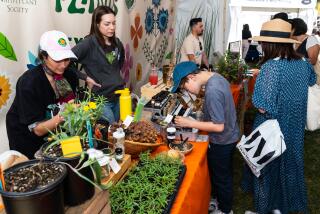GARDENING : Annuals Honors Go to Plants With a History
- Share via
Two centuries-old favorites--snapdragons and watermel ons--are the National Garden Bureau’s plants of the year for 1994.
Announcement of the “Year of the Watermelon” and “Year of the Snapdragon” was made in advance of National Garden Week, April 10-16.
Hieroglyphics on ancient Egyptian tombs show watermelons in cultivation there thousands of years ago. Snapdragons, native to the Mediterranean region, were described by Dioscorides, an ancient Greek physician and botanist.
A little planning can forestall a lot of problems in growing both, suggests the bureau, which was founded in 1920 and describes itself as a nonprofit service providing information on gardening.
Both watermelon and snapdragons are grown as annuals in much of the United States, although snapdragons (Antirrhinum majus) can be perennials here and in other areas where summer temperatures are not too intense and winters stay over 10 degrees. Watermelons (Citrullus lanatus) are annuals.
Watermelon seeds need both warm soil and warm air to germinate. Soil should have reached 70 to 75 degrees.
“The best soil for growing watermelons is a light, fertile, sandy one with a pH of 5.5 to 6.5,” the bureau says. “If the soil tends to be heavy or has a high clay content, add a few shovels of coarse sand to improve drainage. Till the soil to a depth of six to eight inches and add well-rotted manure or compost.”
Snapdragons prefer soil with a neutral pH, numerically equal to seven, and “amend heavy soil with aged compost or sphagnum peat moss” to keep roots from becoming constricted or damaged. A sunny location is suggested for all but the hottest areas, where some shade is needed.
“Snapdragons are relatively disease and pest-free,” says the bureau, and it suggests keeping the garden clean as the first line of defense.
The original snapdragons were white and purple. Today they come in every color except blue, as well as bicolor, and are good cut flowers. They need moderate amounts of fertilizer and water.
Watermelon varieties range from small bush types with vines three- to five-feet long through those sprawling six to 12 feet. There are six major classes: Ice Box, weighing from five to 15 pounds; Sugar Baby, eight to 12 pounds; Charleston Grey, 20 to 30 pounds; Allsweet, 20 to 35 pounds, and Seedless, weighing 10 to 20 pounds. Four of the classes also refer to a variety of the same name.
Shapes are round like a basketball, oval like a football or stretch into an oblong, cylindrical form.
Flesh color also varies. Most are red, but yellow and orange also are popular. They taste about the same.
Some seeds are possible in seedless types, but they are edible. The bureau says there seems to be an increasing trend toward seedless.
As for the age-old question--how do you tell when a melon is ripe?--the bureau says there are a number of clues to judge maturity, none of which is 100% reliable.
For example, a melon thumped during the growing season gives a light ring, but the sound at maturity is resonant, solid and dull.
Or count 35 days from the opening of the first female flowers.
Or observe the place on the watermelon where it rests on the ground. It turns a creamy or golden yellow color when ripe.
Many growers favor the tendril check, claiming the curly tendrils on the vine nearest to the melon become dried out and turn brown at maturity.






